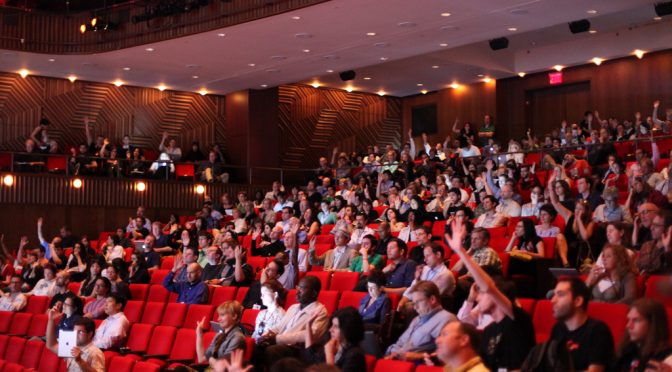EdSurge news recently published a summary of the 2017 Games for Change Festival that happened in New York City this week. Please follow the link below for the full article. I’ve attended G4C for several years now, and my experience has waxed and waned as the conference has shifted its focus from year-to-year. Without going into great detail, I’ll list a few of what I see as the PROs and CONs of the conference. I know it might sound like a rant, but I’m really hoping conference organizers will find better ways to facilitate growth in the field. Speaking of which, don’t forget to sign up for the CUNY Games Conference!
PROs
- The conference started with an invitational VR Brain Jam associated with the VR for Change Summit, where neuroscientists were paired randomly with game development teams to create an experience for virtual reality. This was the absolute highlight of the conference, and I’m hoping that conferences will shift their focus away from traditional lectures to active problem solving sessions. The Learning Sciences have demonstrated that this format is effective in the classroom, so why don’t we apply it to our own conferences? Even the National Science Foundation summits have highly focused problem solving sessions that culminate in products for the general community (e.g., CIRCL Center’s Cyberlearning primers). [Attached is a brief slideshow of our project. Keep in mind we only had 48 hours to develop the project and 2 minutes to present to the group. It was also the first time anyone from the team had attempted networked multiplayer gaming.]
- There were new and interesting tracks. It was interesting to compare the approaches and developments between orthogonal fields like neurogaming and journalism.
- There was a contingent of talented neuroscientists at the conference. While there may have been some psychologists and neuroscientists at previous conferences, this was the first year I recognized people from the mainstream (i.e., people I new in the field, people I might also run into at the annual meeting for the Society for Neuroscience, or people who had a deep knowledge of the scientific literature). Acknowledging that they are also socio-cultural experiences, we can’t forget that games are primarily psychological experiences, and learning is ultimately a physiological process. The scientists that came to the festival this year brought a much needed perspective on perception, attention, learning, emotion, methodology, and analysis.
- I didn’t participate in the format, but the “speed dating for devs” seemed to be a really great way of making connections and amplifying the network.
- There were good opportunities for networking between sessions.
- There were some great keynote speakers (see the EdSurge article).
CONs
- There continues to be a lack of data, solid research methodologies, or even an attempt to measure the impact, efficacy, or scaleability of games for change. I’m not a fan of trial-and-error, particularly when important/timely solutions are needed or taxpayer money is used. Games for Change has always felt like a cheerleading session for me, but I’m not alone. The developers I spoke with didn’t get much from the talks either. Most wanted more technical details, emphasis on innovations, and discussions about things that didn’t work in the production pipeline.
- While there were many great keynote speakers, there were also many that fell flat. The absence of key figures in the field was noticeable.
- Everything ran late.
- There was never enough food, and the food options weren’t great. I’d pay a little more to bring in vendors.
- There was way too much room allocated to the keynotes and not nearly enough for the breakout sessions.
Has the Game Really Changed? Notes From the 2017 Games for Change Festival | EdSurge News



